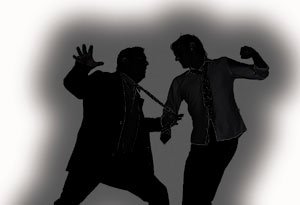Judy Jacobs was in one of her first jobs as a nurse in 1973,
staffing the clinic at an east side Detroit Chrysler foundry, when
the brutality of workplace violence claimed a victim in front of
her.
Judy Jacobs was in one of her first jobs as a nurse in 1973, staffing the clinic at an east side Detroit Chrysler foundry, when the brutality of workplace violence claimed a victim in front of her.
She saw a guard die, shot by a disgruntled employee whom the guard had written up for being late.
“The guy stood over him with the carbine and wouldn’t let me go to him until he was sure he had died,” Jacobs recalled.
Jacobs developed one of the first workplace crisis response teams in Michigan in conjunction with a law enforcement agency in 1983, and helped deal with the emotional wreckage of a rampage at the Royal Oak, Mich., post office in 1991.
“The reason I got into this is because I had a co-worker killed in front of me,” she said.
Workplace violence is in the news now because of the murder of Yale doctoral student Annie Le. After she went missing just days before her wedding, Le’s body was found stuffed behind a wall at the research lab where she worked.
Police arrested a co worker, lab technician Raymond Clark III. The New Haven police chief, while giving few details, said the murder was an example of “workplace violence.”
Workplace attackers usually don’t just explode, said Jacobs, a professor in human resources education at Oakland University. If you’re attuned to warning signs, perpetrators usually telegraph their motives.
“They’ve created a targeted list and they usually tell co-workers what their plan is and who they’re going after,” Jacobs said.
That was the case in the 1991 Royal Oak shootings. Fired postal employee Thomas McIlvane told colleagues and union officials that if he lost his bid to get his job back, he’d make the 1986 murders of 14 postal workers in Oklahoma look “like a tea party.” McIlvane ultimately shot to death four postal workers and injured four others before killing himself.
Clark French, now 54 of Sterling Heights, Mich., was one of those who survived, enduring 10 operations to deal with gunshot damage to his liver, colon and gall bladder.
“I don’t think people take it as lightly as they once did,” French said. “In my case, employers actually ignored the situation.
“We made a lot of jokes when he was making threats – like ‘you’re on his list now,'” French said. “But we also knew he was capable of doing what he was promising to do.”
While incidents such as the Royal Oak shooting and the slaying of Annie Le get attention, said Jacobs, what you encounter more often in the workplace is “the stalking, the bullying, domestic violence and different types of harassment. They can result in terrible things happening and lawsuits.”
From 1997 to 2007, there were more than 7,000 occupational homicides nationwide, according to the U.S. Bureau of Labor Statistics. Most of them involved robberies – retail workers, for example, shot during a holdup. But 1,000 involved work colleagues, the BLS reported.
In 2008 in Michigan, there were 22 assaults and violent acts reported at workplaces, including 13 homicides, according to the Bureau of Labor Statistics.
Employers have a general duty to provide a place of employment that’s free from recognized hazards that can cause death or serious physical injury, said Adrian Rocskay, director of the general industry safety and health division of the Michigan Occupational Safety and Health Administration.
The state has no specific regulations on workplace violence, but MIOSHA recommends employers evaluate whether they need violence prevention programs.
“Many companies are doing something after the fact,” Rocskay said.













